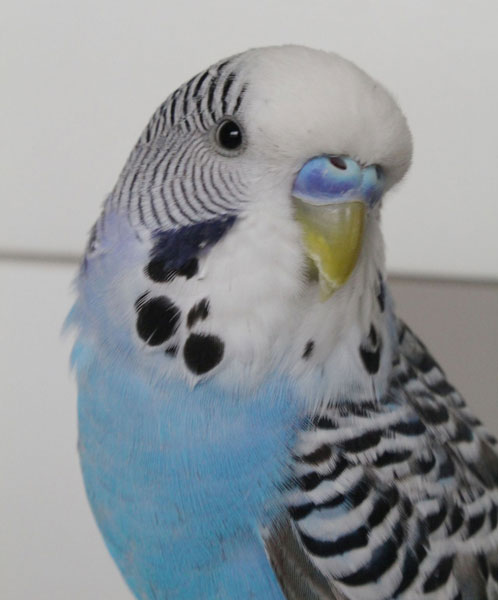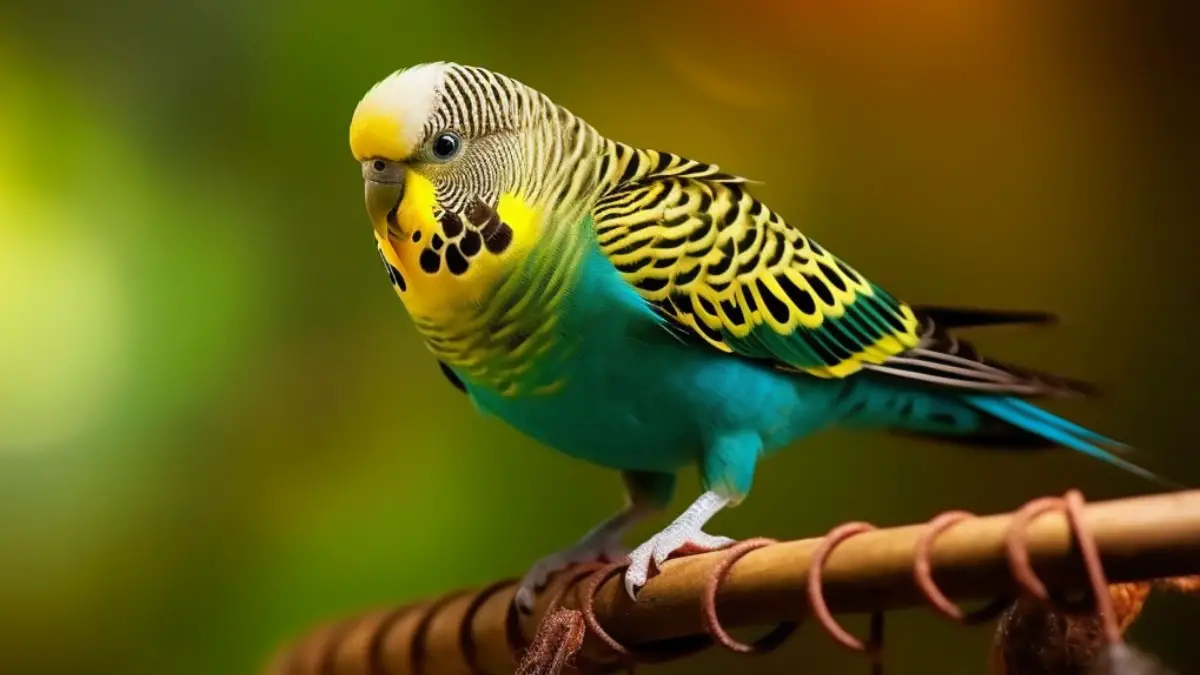The cere of a budgie is the region above its beak. Consider it a budgie’s beak containing the nostrils. However, because the cere is incapable of detecting odor, budgies’ sense of smell is underdeveloped. Instead, it is one of the best indicators of a budgie’s sex, maturity, and overall health. Thankfully, male and female ceres have distinct coloration.
The difference between adult male and female budgies is straightforward: The cere of males is blue, whereas the cere of females is tan or brown. Invariably, the female cerebrum will be considerably lighter than the male cerebrum. You can observe the distinction as early as the third week of a budgerigar’s life.
Having multiple baby budgies together makes it easier to distinguish between them because you can compare their ceres. We will discuss the various colors of ceres, how to differentiate between male and female budgies and cere problems that budgies experience. Continue reading to gain knowledge about the budgie cere chart.
Budgie Cere Chart: Different Cere Colors & Their Meaning

Here is a table showing different colors of budgies’ ceres and their meanings.
| Cere color | Means |
| The Pale blue or whitish | Color of an adult female cere. |
| Dark blue | Color of an adult male cere. |
| White | Color of a stressed male cere or a normal female cere. |
| Pink | Color of baby budgies cere and mutated budgies. |
| Red | Color of an inflamed cere. |
| Purple | is the Normal color of an adult male cere. |
| Brown | Signifies breeding season in females. It signifies illness in males. |
When budgies are born, they have pink ceres. However, in case of a mutation, you can have baby budgies with light blue or white ceres. Ceres will change color approximately one year into a budgerigar’s existence.
During the first year, budgies undergo their first molt, which includes the cere changing color. However, some budgies’ cere will change color earlier or later than others. A change in cere color is one of the most consistent indicators that your budgie matures from a juvenile to an adult.

Females will have light blue ceres that turn brown during breeding and as they age, whereas males have pale pink or purple ceres, with some changing to bright blue as they age. However, the cere’s color of a sick budgerigar may also alter.
Brown ceres in males may indicate testicular cancers or mite infestations. White and red ceres are most likely stress-related or are caused by a mutation. Also, hormonal imbalance may cause a blue cere to have white streaks.
The Cere Color Of A Male Budgie
Male budgies have ceres with purple, pink, or blue hues. As the budgie gets older, the cere’s color becomes regal blue. However, the color intensity varies based on the individual’s present hormone levels and health. Therefore the blue cere color will become lighter when the male budgie is not in the mood to procreate.
This difference in hue resulting from the breeding condition is not as evident as in budgie females. Also, in some instances, males’ ceres do not change color; they remain pale pink. For example, in the Lutino budgie, albino budgie, transparent budgie, lacing parakeet, and the dusky budgie.

If the male cere is turning brown, it may have a medical condition. The cere may also appear a bit drab and have less vibrant coloring. In addition, the cere of sick or elderly male budgies is frequently rough and may even partially peel. However, this can also occur in sexually mature males in breeding conditions, which indicates a nutritional deficiency.
The Cere Color Of A Female Budgie
A female adult budgie’s cere is usually whitish or pale blue. As she enters the breeding condition, the cere becomes tan or brownish. An additional fascinating fact is that only females have a white circle around their nostrils. The cere will also develop a flaky texture.
This texture can build up to a centimeter in thickness, which makes the cere appear swollen, but it is normal. Veterinarians refer to a swollen cere as hyperkeratosis. It can also be a sign of illness, so to ensure that the bird is not gravely unwell, consult an avian veterinarian.

The cere’s brown color indicates that the bird is healthy and ready to reproduce. The cere usually is pale blue or whitish when a sexually mature female is hormonally dormant. Depending on whether it is during breeding season or not, a female budgie’s cere will change color from light blue to brown.
A non-hormonal female budgie has a pale blue cere, whereas males have a dark blue cere. As a result, gender distinction is based on the magnitude of the blue color.
Why Does My Female Budgie Have A Blue Cere?

A female budgie may have a blue cere for the following reasons:
Hormone Imbalance
As I mentioned, when a female budgie is hormonally inactive, the cere will be a light blue or whitish. There may be a hormonal imbalance in females if it has a deep blue cere with no white streaks.
Your female budgie is likely to be sick if she has had a pale blue cere for an extended period, as this can inhibit estrogen synthesis. It could also be due to a hormonal imbalance in the bird. However, healthy females may have an extremely light-blue cere due to natural color variation rather than illness.
Mutations
A mutation in the female budgie’s genes can cause the cere to turn blue. It is, therefore, natural for some female budgies to have a blue cere. Some gene variations cause a female baby budgie to begin her life with a blue or white cere which will not change throughout its life.

Testosterone levels
Studies also show that some female parakeets have elevated testosterone levels which may result in a blue cere. However, the female blue cere will not reach the same level of “blueness” as that of male budgerigars.
Why Is The Cere of My Budgie Turning Brown and Crusty?
Female budgies’ cere naturally turns brown and crusty when the budgies are in breeding condition. However, if the cere is more crusty than usual, it could mean that the budgie is sick. In male budgerigars, a brown cere automatically shows there is something wrong with it. Let’s look at some common reasons for brown ceres.

Hyperkeratosis
Hyperkeratosis occurs when the cere thickens. It happens mainly during the breeding season in females when the amount of keratin increases. However, lousy health might create this condition. For instance, a shortage of vitamin A can cause hyperkeratosis in budgies fed an imbalanced diet.
It can also be caused by arsenic poisoning from the soil, water, and specific foods. If hyperkeratosis is a disease symptom, you must take your budgie to the veterinarian, primarily if the growth covers its nose and makes breathing difficult. Soak the crust in mineral oil and remove the scales with a cotton swab to remove excess keratin.
Face Mites
Face mites reside on the bare skin of budgies. If left untreated, facial mites can infest the entire body. The mites typically begin as a brown growth on the cere. One way your budgie can get facial mites is by sharing a meal with an infested budgie and when they are preening each other.

If left untreated, scaly face mites can cause hyperkeratosis and lead to beak malformations. You can use Ivermectin to treat facial mites.
Testicular malignancy
Testicular tumors are prevalent in male budgies. One of the main symptoms is a crusty and brown cere. The budgie may also ensure limpness, weight loss, and a swollen cere. Veterinarians can manage testicular cancers by surgically removing the tumor. Pain and discomfort are then addressed with medication.
Vitamin A Deficiency
A brown and crusty cere could signify a vitamin A deficiency. Other symptoms include white dots on the eyes, cere, and budgie’s beak. Ensure you have Vitamin A-containing foods in your budgie’s diet, such as red and orange vegetables and leafy greens.

Brown Cere Hypertrophy
Hypertrophy is a disease caused by an excess of estrogen resulting from an imbalance in protein and vitamins. Brown cere hypertrophy is not harmful unless it causes the nostrils to get blocked, which might lead to respiratory difficulties in your budgie. The disorder can be treated in several ways, i.e., by a healthy diet and fresh water and by stopping breeding.
Why Is The Cere of My Budgie White?
In male budgies, ceres turn whitish if they fail to produce enough testosterone due to stress. To solve this, you must change the budgie’s living conditions and take it to a vet for further diagnosis. In females, a whitish or pale color is standard. The color only changes during the breeding season.

Why Is the Cere of My Budgie Peeling?
Peeling is average in female budgies, especially in breeding seasons. Afterward, the crust falls off, revealing the standard cere color. Other reasons are;

- Molting; when a budgie is experiencing molting, its cere and other portions of its body become flaky.
- Dry Skin; lack of humidity and dehydration can cause the budgie’s cere to peel. To counter this, utilize a humidifier and coconut oil for moisturizing the dry cere. Also, ensure you provide the budgie with fresh water to prevent dehydration.
FAQs
Here are other related questions about the budgie cere chart.
A pink cere is present in babies and other budgies with variant genes. They include albinos, lutinos and fallows, and lacewing budgies.
A red cere indicates an illness and is also a sign of stress or inflammation. Check for other symptoms associated with inflammation or clogged nostrils.
Conclusion
All baby budgies have a pink cere except for those born with defects—an adult male cere changes from pink to a dark blue or purple. An adult female’s cere becomes a pale blue with white streaks. However, the female’s cere turns to a tan-brown shade during breeding.
These color changes usually happen when the budgie is a year old. They are great indicators to understand your budgie’s health condition, so get a good idea about them to be able to inspect any issues related to your budgie on your own.








